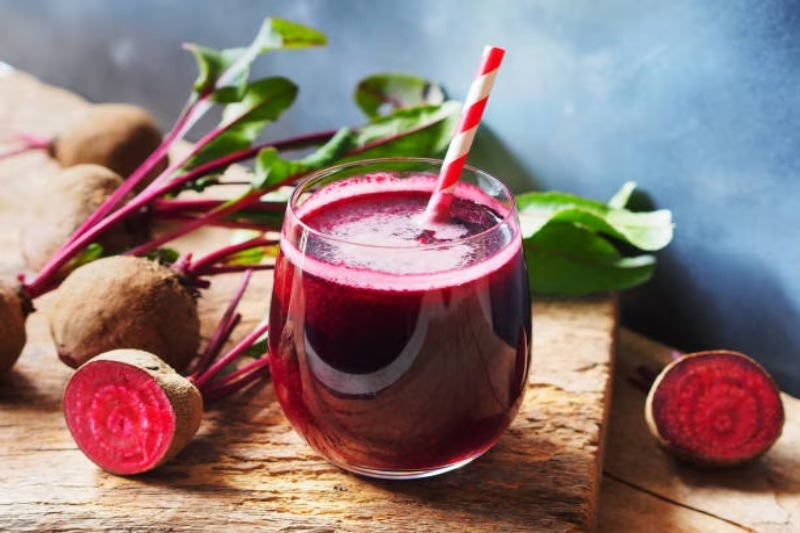American researchers summarized the benefits of beetroot juice (BRJ) for exercise capacity and physiological function in a review article that was recently published in the journal Frontiers in Nutrition.
They came to the conclusion that because BRJ has a wider range of phytonutrients than dietary nitrate (NO3-) and nitrate salts (NIT), it is more beneficial for improving training and recovery outcomes.
It is well recognized that dietary nitrates have advantages for exercising.
By lowering the oxygen cost of aerobic exercise, nitrate supplements can improve muscular contractility, vascular function, exercise efficiency and performance, training adaptations, and the reduction of muscle soreness and injury.
These advantages are believed to be brought about by the body producing more nitric oxide, which reduces blood pressure and controls other physiological reactions. Beets and leafy greens are excellent providers of NO3-, and if NO3-doses are same, it has long been believed that the benefits of BRJ and NIT are equivalent.
This assumption, however, ignores the many polyphenols and other parts of BRJ that might be more beneficial than NIT—that is, benefits unrelated to its nitrate-richness.
BRJ has a high nitrate content along with other nutrients like potassium, magnesium, folic acid, ascorbic acid, and biotic. BRJ contains polyphenolic substances such as betanin and other betacyanins.
Since NO3-free BRJ does not significantly alter muscle metabolism, exercise performance, or oxygen uptake, it is possible that other physiologically active components of BRJ function in concert with the nitrates rather than separately.
NIT vs BRJ Comparison for Outcomes Related to Exercise
During moderate-intensity activity, no significant differences were detected in the early trials that showed the superiority of BRJ over NIT; nevertheless, during high-intensity exercise, BRJ dramatically reduced oxygen consumption.
This could be as a result of BRJ increasing mitochondrial efficiency and exercise economy. These results were corroborated by a more recent investigation, which also discovered that BRJ prolonged the period of time before high-intensity workout weariness occurred.
Based on these findings, researchers have theorized that BRJ may be more successful in reducing the cost of oxygen during high-intensity aerobic activity, which would improve performance.
Why this impact is observed at intermediate nitrate levels but not at lower or higher ones is still up for debate. One significant disadvantage of these research is the challenge of blinding clinical trial participants to the clear distinctions between NIT and BRJ.
Mechanisms by which BRJ might Benefit from Exercise More
Scientists have hypothesized that, in contrast to NIT, the other ingredients in BRJ, such as polyphenols, may enhance NO3- absorption. However, after consuming NIT and BRJ for two to four hours, plasma NO3- and NO2-levels seem to be the same.
This implies that the observed variations may have resulted from variations in nitrate bioavailability that were not noticed, especially as at least one of the studies did not evaluate the NO3- levels in the BRJ supplement, which frequently fluctuate greatly.
Interestingly, a study comparing the effects of BRJ and NIT on the recovery from eccentric exercise did not find any difference in the amount of muscle damage after many drop jumps, but it did reveal that BRJ greatly decreased the soreness in the muscles. Its antioxidant and anti-inflammatory qualities might be the cause of this.
There are signs that BRJ may lessen the physiological stress associated with training, enabling more intense training and improved training-related results. This was discovered in another study that examined sprint interval training. However, due to the short sample size, the conclusions cannot be fully generalized, and high-performing outliers may have a substantial impact.
In Conclusion
There seem to be signs that BRJ may be better than NIT for specific exercise-related outcomes.
It can be inferred that other components of BRJ, such as polyphenols, are working in concert with nitrates to improve exercise effects if NO3- levels are actually similar between the two, which hasn’t always been proven. To determine which elements, if any, are responsible for these effects and how they function, more investigation is necessary.
Furthermore, BRJ and NIT appear to have equal nitrate bioavailability based on their effects on blood pressure; therefore, it’s plausible that these components delay or lessen cellular damage instead of increasing bioavailability. There is currently little proof that the reason BRJ works so well is because it lessens oxidative tissue damage.
Topics #Beetroot Juice #Boosting Exercise Outcomes










